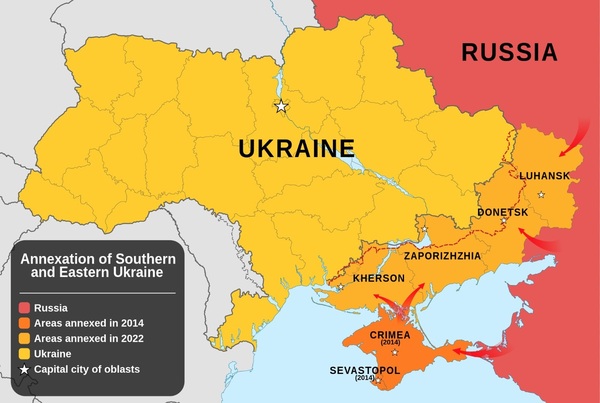
–>
October 2, 2022
Russia just annexed four provinces previously considered part of Ukraine. Annexing the land of another country acquired by war is illegal according to international law… or so they say.
‘); googletag.cmd.push(function () { googletag.display(‘div-gpt-ad-1609268089992-0’); }); }
But if the residents of such land decide by referendum to secede and declare independence, before being annexed by another country, such as what transpired with respect to Crimea in 2014 and now and the four eastern provinces formerly part of Ukraine, does this make the annexation legal? Possibly. It all depends if the residents had the right to secede and whether the referendum was properly executed.
Israel avoids this controversy by extending Israeli law to the land rather than annexing it.
Crimea and the four provinces
‘); googletag.cmd.push(function () { googletag.display(‘div-gpt-ad-1609270365559-0’); }); }
In March 2014, Russia annexed the Crimea Peninsula, which had been a part of Ukraine since 1991 and now administers the territory as two federal entities — the Republic of Crimea and the federal city of Sevastopol.

Russia rejects the view that this was an annexation and regards it as an accession to the Russian and considers it secession as a result of irredentism. A term often used in Russia to describe these events is “re-unification” to highlight the fact that Crimea was a part of the Russian Empire from 1783 to 1917, and part of the Russian Soviet Federative Socialist Republic from 1921 to 1954. Few states recognize this view.
Ukraine considers Crimea and Sevastopol its own territory.
It should be noted that Crimea differs from the four provinces in that:
The new Constitution of Ukraine, the Crimea was declared to be the “Autonomous Republic of Crimea”, but also an “inseparable constituent part of Ukraine”. Being an “autonomous republic” it could be argued that it had the right to secede which it purported to do.
Irredentism is the doctrine of political or popular movements that claim and seek to occupy (usually on behalf of their members’ nation) territory considered “lost” (or “unredeemed”) to the nation, based on history or legend. The scope is occasionally subject to disputes about underlying claims of expansionism, owing to lack of clarity on the historical bounds of putative nations or peoples.
‘); googletag.cmd.push(function () { googletag.display(‘div-gpt-ad-1609268078422-0’); }); } if (publir_show_ads) { document.write(“
This term also often refers to revanchism, though the difference between the two is, according to Merriam-Webster, that revanchism means the recovery of lost territory, while irredentism is the reunion of politically or ethnically displaced territory, along with a population having the same national identity.
It is plain to see that in both cases, the breakaway regions decided by referenda to declare independence before being annexed by Russia. Of course, Ukraine says these regions did not have the right to secede and each referendum was a “sham”.
Yet, possession, as they say, is 9/10 of the law and Russia is clearly “in possession” at the moment.
Another example of secession is the declaration of independence by Kosovo in 2008. It is not recognized by Serbia and 76 of the 193 countries in the world.
It remains to be seen how many countries will recognize the four provinces and Crimea as Russian territory.
The Golan Heights
In 1981, Israel passed the Golan Law, which extended Israeli law to the Golan Heights, captured from Syria in 1967. Although the law did not use the term, it was considered by the international community as an “annexation” of the Golan Heights.
The US recognized the Golan Heights as part of Israel through a presidential proclamation signed by President Trump on March 25, 2019. The proclamation cited “aggressive acts by Iran and terrorist groups, including Hezbollah in southern Syria” as justification for Israel to maintain sovereignty over the Golan Heights as Israel has a “need to protect itself from Syria and other regional threats.”
In refuting a supposed double standard in recognizing Israel’s annexation of the Golan Heights but placing sanctions on Russia for annexing Crimea in 2014, Secretary of State Mike Pompeo said “What the President did with the Golan Heights is recognize the reality on the ground and the security situation necessary for the protection of the Israeli state. It’s that — it’s that simple.” A State Department spokesperson claimed the day following the proclamation that “Israel gained control of the Golan through its legitimate response to Syrian aggression aimed at Israel’s destruction.”
An anonymous Israeli official echoed Netanyahu’s claims, telling the Washington Post that the recognition of the Golan Heights was justified since the occupied territory was gained in a “defensive war”.
““To Israel, Trump’s Golan Heights decision is a no-brainer: It says occupying territory gained in a defensive war is justifiable””
Of course this contradicts UNSC Resolution 242, which began with the preamble “Emphasizing the inadmissibility of the acquisition of territory by war…” and rightly so. International law recognizes the right to retain territory occupied in a defensive war. It is for this reason that Res 242 did not require Israel to give back all the conquered land.
Judea and Samaria aka, West Bank
Journalists and politicians often talk about Israel’s desire to annex Judea and Samaria. They are wrong in so doing because what Israel talks about doing is extending Israeli law to these lands the same as it did in the Golan Heights law.
This distinction is very important because Judea and Samaria are not the land of another country. All that is necessary is to extend Israeli law to the territory which in effect extends Israeli sovereignty to such lands.
The Fourth Geneva Convention (1949)(FGC) purports to protect civilians in times of war.
Article 49. Individual or mass forcible transfers, as well as deportations of protected persons from occupied territory to the territory of the Occupying Power or to that of any other country, occupied or not, are prohibited, regardless of their motive.
-The Occupying Power shall not deport or transfer parts of its own civilian population into the territory it occupies.
Pursuant to this article, the international community considers the Israeli settlements as illegal because Israel is transferring parts of its population to these territories. But this disregards the fact it covers “forcible transfers,” Israel is not transferring anyone forcibly. The settlement movement is entirely voluntary.
Equally germane is the fact that the FGC does not apply to these lands.
ART. 2. — In addition to the provisions which shall be implemented in peacetime, the present Convention shall apply to all cases of declared war or of any other armed conflict which may arise between two or more of the High Contracting Parties, even if the state of war is not recognized by one of them.
Since Jordan’s annexation of these was recognized by only 3 countries, these lands are not lands of a High Contracting Party. For this reason Israel did not ratify the treaty and therefore is not bound by it.
Nevertheless Israel has agreed to abide by the humanitarian provisions.
East Jerusalem
On 27 June 1967, Israel expanded the municipal boundaries of West Jerusalem so as to include approximately 70 km2 (27.0 sq mi) of West Bank territory today referred to as East Jerusalem. On 30 July 1980, the Knesset officially approved the Jerusalem Law, which called the city the complete and united capital.
Although the law did not use the term, the Israel Supreme Court interpreted the law as an effective annexation of eastern Jerusalem. The UNSC condemned the attempted change in status to Jerusalem and ruled the law “null and void” in UNSC Res 478:
“…all legislative and administrative measures and actions taken by Israel, the occupying Power, which purport to alter the character and status of the Holy City of Jerusalem have no legal validity and constitute a flagrant violation of the Fourth Geneva Convention“
It should be noted that The Security Council is not a court of law and this resolution is only a recommendation.
In 1995, Congress adopted the Jerusalem Embassy Act, maintaining that:
(1) Jerusalem remain an undivided city in which the rights of every ethnic religious group are protected;
(2) Jerusalem be recognized as the capital of the State of Israel; and
(3) the U.S. Embassy in Israel be established in Jerusalem
This act passed Congress by an overwhelming bipartisan majority and was reaffirmed by a unanimous vote of the Senate only six months later.
Pursuant to this Act, President Trump, on Dec 6, 2020, recognized Jerusalem as the capital of Israel. However he added:
“We are not taking a position of any final status issues, including the specific boundaries of the Israeli sovereignty in Jerusalem, or the resolution of contested borders. Those questions are up to the parties involved.”
Congress did not stipulate so. In fact, it referred to Jerusalem as the undivided city and that was 15 years after Israel passed the Jerusalem Law enlarging the boundaries of Jerusalem to include, inter alia, the eastern part. So Trump’s reservation was uncalled for at least by Congress.
The International Court of Justice (ICJ) identifies the sources of international law in the ICJ Statute, The United Nations is not among them but is a forum for adopting multilateral treaties. Many multilateral treaties are in fact adopted by the General Assembly and subsequently opened for signature and ratification. But these treaties are only binding on the parties that sign them.
So much for international law.
Map credit: Basque mapping CC BY-SA 4.0 license
<!– if(page_width_onload <= 479) { document.write("
“); googletag.cmd.push(function() { googletag.display(‘div-gpt-ad-1345489840937-4’); }); } –> If you experience technical problems, please write to [email protected]
FOLLOW US ON
<!–
–>
<!– _qoptions={ qacct:”p-9bKF-NgTuSFM6″ }; ![]() –> <!—-> <!– var addthis_share = { email_template: “new_template” } –>
–> <!—-> <!– var addthis_share = { email_template: “new_template” } –>





